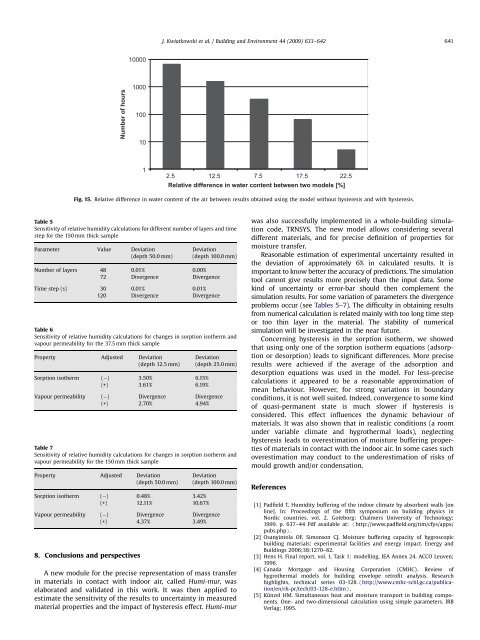Modelling of hysteresis influence on mass transfer in building ...
Modelling of hysteresis influence on mass transfer in building ...
Modelling of hysteresis influence on mass transfer in building ...
Create successful ePaper yourself
Turn your PDF publications into a flip-book with our unique Google optimized e-Paper software.
ARTICLE IN PRESSJ. Kwiatkowski et al. / Build<strong>in</strong>g and Envir<strong>on</strong>ment 44 (2009) 633–642 64110000Number <str<strong>on</strong>g>of</str<strong>on</strong>g> hours10001001012.512.5 7.517.522.5Relative difference <strong>in</strong> water c<strong>on</strong>tent between two models [%]Fig. 15. Relative difference <strong>in</strong> water c<strong>on</strong>tent <str<strong>on</strong>g>of</str<strong>on</strong>g> the air between results obta<strong>in</strong>ed us<strong>in</strong>g the model without <str<strong>on</strong>g>hysteresis</str<strong>on</strong>g> and with <str<strong>on</strong>g>hysteresis</str<strong>on</strong>g>.Table 5Sensitivity <str<strong>on</strong>g>of</str<strong>on</strong>g> relative humidity calculati<strong>on</strong>s for different number <str<strong>on</strong>g>of</str<strong>on</strong>g> layers and timestep for the 150 mm thick sampleParameter Value Deviati<strong>on</strong>(depth 50.0 mm)8. C<strong>on</strong>clusi<strong>on</strong>s and perspectivesDeviati<strong>on</strong>(depth 100.0 mm)Number <str<strong>on</strong>g>of</str<strong>on</strong>g> layers 48 0.01% 0.00%72 Divergence DivergenceTime step (s) 30 0.01% 0.01%120 Divergence DivergenceTable 6Sensitivity <str<strong>on</strong>g>of</str<strong>on</strong>g> relative humidity calculati<strong>on</strong>s for changes <strong>in</strong> sorpti<strong>on</strong> isotherm andvapour permeability for the 37.5 mm thick sampleProperty Adjusted Deviati<strong>on</strong>(depth 12.5 mm)Sorpti<strong>on</strong> isotherm ( ) 3.50% 6.15%(+) 3.61% 6.19%Deviati<strong>on</strong>(depth 25.0 mm)Vapour permeability ( ) Divergence Divergence(+) 2.70% 4.94%Table 7Sensitivity <str<strong>on</strong>g>of</str<strong>on</strong>g> relative humidity calculati<strong>on</strong>s for changes <strong>in</strong> sorpti<strong>on</strong> isotherm andvapour permeability for the 150 mm thick sampleProperty Adjusted Deviati<strong>on</strong>(depth 50.0 mm)Sorpti<strong>on</strong> isotherm ( ) 0.48% 3.42%(+) 12.11% 10.67%Deviati<strong>on</strong>(depth 100.0 mm)Vapour permeability ( ) Divergence Divergence(+) 4.37% 3.49%A new module for the precise representati<strong>on</strong> <str<strong>on</strong>g>of</str<strong>on</strong>g> <strong>mass</strong> <strong>transfer</strong><strong>in</strong> materials <strong>in</strong> c<strong>on</strong>tact with <strong>in</strong>door air, called Humi-mur, waselaborated and validated <strong>in</strong> this work. It was then applied toestimate the sensitivity <str<strong>on</strong>g>of</str<strong>on</strong>g> the results to uncerta<strong>in</strong>ty <strong>in</strong> measuredmaterial properties and the impact <str<strong>on</strong>g>of</str<strong>on</strong>g> <str<strong>on</strong>g>hysteresis</str<strong>on</strong>g> effect. Humi-murwas also successfully implemented <strong>in</strong> a whole-build<strong>in</strong>g simulati<strong>on</strong>code, TRNSYS. The new model allows c<strong>on</strong>sider<strong>in</strong>g severaldifferent materials, and for precise def<strong>in</strong>iti<strong>on</strong> <str<strong>on</strong>g>of</str<strong>on</strong>g> properties formoisture <strong>transfer</strong>.Reas<strong>on</strong>able estimati<strong>on</strong> <str<strong>on</strong>g>of</str<strong>on</strong>g> experimental uncerta<strong>in</strong>ty resulted <strong>in</strong>the deviati<strong>on</strong> <str<strong>on</strong>g>of</str<strong>on</strong>g> approximately 6% <strong>in</strong> calculated results. It isimportant to know better the accuracy <str<strong>on</strong>g>of</str<strong>on</strong>g> predicti<strong>on</strong>s. The simulati<strong>on</strong>tool cannot give results more precisely than the <strong>in</strong>put data. Somek<strong>in</strong>d <str<strong>on</strong>g>of</str<strong>on</strong>g> uncerta<strong>in</strong>ty or error-bar should then complement thesimulati<strong>on</strong> results. For some variati<strong>on</strong> <str<strong>on</strong>g>of</str<strong>on</strong>g> parameters the divergenceproblems occur (see Tables 5–7). The difficulty <strong>in</strong> obta<strong>in</strong><strong>in</strong>g resultsfrom numerical calculati<strong>on</strong> is related ma<strong>in</strong>ly with too l<strong>on</strong>g time stepor too th<strong>in</strong> layer <strong>in</strong> the material. The stability <str<strong>on</strong>g>of</str<strong>on</strong>g> numericalsimulati<strong>on</strong> will be <strong>in</strong>vestigated <strong>in</strong> the near future.C<strong>on</strong>cern<strong>in</strong>g <str<strong>on</strong>g>hysteresis</str<strong>on</strong>g> <strong>in</strong> the sorpti<strong>on</strong> isotherm, we showedthat us<strong>in</strong>g <strong>on</strong>ly <strong>on</strong>e <str<strong>on</strong>g>of</str<strong>on</strong>g> the sorpti<strong>on</strong> isotherm equati<strong>on</strong>s (adsorpti<strong>on</strong>or desorpti<strong>on</strong>) leads to significant differences. More preciseresults were achieved if the average <str<strong>on</strong>g>of</str<strong>on</strong>g> the adsorpti<strong>on</strong> anddesorpti<strong>on</strong> equati<strong>on</strong>s was used <strong>in</strong> the model. For less-precisecalculati<strong>on</strong>s it appeared to be a reas<strong>on</strong>able approximati<strong>on</strong> <str<strong>on</strong>g>of</str<strong>on</strong>g>mean behaviour. However, for str<strong>on</strong>g variati<strong>on</strong>s <strong>in</strong> boundaryc<strong>on</strong>diti<strong>on</strong>s, it is not well suited. Indeed, c<strong>on</strong>vergence to some k<strong>in</strong>d<str<strong>on</strong>g>of</str<strong>on</strong>g> quasi-permanent state is much slower if <str<strong>on</strong>g>hysteresis</str<strong>on</strong>g> isc<strong>on</strong>sidered. This effect <str<strong>on</strong>g><strong>in</strong>fluence</str<strong>on</strong>g>s the dynamic behaviour <str<strong>on</strong>g>of</str<strong>on</strong>g>materials. It was also shown that <strong>in</strong> realistic c<strong>on</strong>diti<strong>on</strong>s (a roomunder variable climate and hygrothermal loads), neglect<strong>in</strong>g<str<strong>on</strong>g>hysteresis</str<strong>on</strong>g> leads to overestimati<strong>on</strong> <str<strong>on</strong>g>of</str<strong>on</strong>g> moisture buffer<strong>in</strong>g properties<str<strong>on</strong>g>of</str<strong>on</strong>g> materials <strong>in</strong> c<strong>on</strong>tact with the <strong>in</strong>door air. In some cases suchoverestimati<strong>on</strong> may c<strong>on</strong>duct to the underestimati<strong>on</strong> <str<strong>on</strong>g>of</str<strong>on</strong>g> risks <str<strong>on</strong>g>of</str<strong>on</strong>g>mould growth and/or c<strong>on</strong>densati<strong>on</strong>.References[1] Padfield T. Humidity buffer<strong>in</strong>g <str<strong>on</strong>g>of</str<strong>on</strong>g> the <strong>in</strong>door climate by absorbent walls [<strong>on</strong>l<strong>in</strong>e]. In: Proceed<strong>in</strong>gs <str<strong>on</strong>g>of</str<strong>on</strong>g> the fifth symposium <strong>on</strong> build<strong>in</strong>g physics <strong>in</strong>Nordic countries, vol. 2. Goteborg: Chalmers University <str<strong>on</strong>g>of</str<strong>on</strong>g> Technology;1999. p. 637–44 Pdf available at: /http://www.padfield.org/tim/cfys/appx/pubs.phpS.[2] Osany<strong>in</strong>tola OF, Sim<strong>on</strong>s<strong>on</strong> CJ. Moisture buffer<strong>in</strong>g capacity <str<strong>on</strong>g>of</str<strong>on</strong>g> hygroscopicbuild<strong>in</strong>g materials: experimental facilities and energy impact. Energy andBuild<strong>in</strong>gs 2006;38:1270–82.[3] Hens H. F<strong>in</strong>al report, vol. 1, Task 1: modell<strong>in</strong>g, IEA Annex 24. ACCO Leuven;1996.[4] Canada Mortgage and Hous<strong>in</strong>g Corporati<strong>on</strong> (CMHC). Review <str<strong>on</strong>g>of</str<strong>on</strong>g>hygrothermal models for build<strong>in</strong>g envelope retr<str<strong>on</strong>g>of</str<strong>on</strong>g>it analysis. Researchhighlights, technical series 03-128./http://www.cmhc-schl.gc.ca/publicati<strong>on</strong>/en/rh-pr/tech/03-128-e.htlmS.[5] Künzel HM. Simultaneous heat and moisture transport <strong>in</strong> build<strong>in</strong>g comp<strong>on</strong>ents.One- and two-dimensi<strong>on</strong>al calculati<strong>on</strong> us<strong>in</strong>g simple parameters. IRBVerlag; 1995.
















